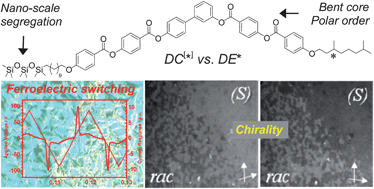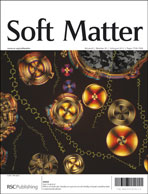Effects of molecular chirality on superstructural chirality in liquid crystalline dark conglomerate phases†
Abstract
The first examples of polyphilic bent-core compounds consisting of a biphenyl central core, a chiral terminal chain and an oligo(dimethylsiloxane) end group at the other terminus have been synthesized and characterized. The mesomorphic behaviour of the compounds was investigated by differential scanning calorimetry, optical polarizing microscopy, X-ray diffraction and electro-optic methods. The olefinic precursors show monotropic or enantiotropic B1 type mesophases. The siloxane substituted analogues containing a racemic chain exhibit dark conglomerate phases (DC[*] phases) which are composed of chiral domains with opposite chirality, whereas the siloxane derivatives with a homogeneously chiral moiety show “dark enantiomer” phases (DE* phases) with uniform chirality. Under electric fields, different types of ferroelectric switching (FE) smectic and modulated smectic phases were induced. The effects of chain branching, spacer length and molecular chirality on the stability of the DCFE[*] and DEFE* phases and on the field-induced smectic and modulated smectic phases were investigated.


 Please wait while we load your content...
Please wait while we load your content...